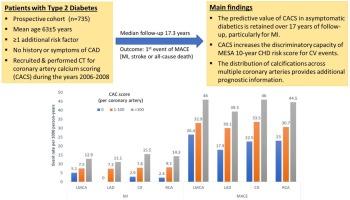The long-term prognostic value of CT coronary artery calcium score in asymptomatic patients with type 2 diabetes
IF 2.5
Q2 CARDIAC & CARDIOVASCULAR SYSTEMS
引用次数: 0
Abstract
Background
Coronary artery calcium scoring (CACS) may improve risk stratification of diabetics, in whom coronary artery disease (CAD) is often more diffuse and progressive. We examined the long-term value of CACS in outcome prediction of asymptomatic patients with type 2 diabetes.
Methods
A population-based cohort recruited between 2006 and 2008 of type 2 diabetics aged 55–74 years, with at least one additional risk factor and no history or symptoms of CAD. The association of overall (n = 735) and individual vessel (n = 596) CACS with the occurrence of myocardial infarction (MI), ischemic stroke, or all-cause death (MACE) was assessed over a median follow-up of 17.3 years.
Results
Increasing levels of CACS independently predicted MACE and its components, particularly MI, with no events of MI observed in those with zero CACS, and an adjusted hazard ratio (95 % confidence interval) of 2.31 (1.30–4.11) for MI in those with CACS > 300 compared to 1–100 Agatston units. The addition of CACS to MESA 10-year coronary heart disease risk score increased significantly the discriminatory capacity for MI [combined AUC 0.75 (0.72–0.78)]. For each additional coronary artery with any CACS, the adjusted HR for MI was 1.68 (1.34–2.10), and for MACE 1.18 (1.08–1.30), p < 0.001. The hazard for MI or MACE did not increase in proportion to the percentage of CACS localized to the left-main coronary artery.
Conclusions
The predictive value of CACS in asymptomatic diabetics is retained over 17 years of follow-up, particularly for MI. The number of coronary arteries with calcified plaques may provide additional prognostic information.

CT冠状动脉钙化评分对无症状2型糖尿病患者的长期预后价值
背景冠状动脉钙化评分(CACS)可以改善糖尿病患者的风险分层,因为糖尿病患者的冠状动脉疾病(CAD)往往更弥漫性和进行性。我们研究了CACS在无症状2型糖尿病患者预后预测中的长期价值。方法以人群为基础的队列,招募年龄在55-74岁之间的2型糖尿病患者,至少有一个额外的危险因素,无CAD病史或症状。总体(n = 735)和单个血管(n = 596) CACS与心肌梗死(MI)、缺血性卒中或全因死亡(MACE)发生的相关性在17.3年的中位随访期间进行了评估。结果CACS水平的升高独立预测了MACE及其组成部分,特别是心肌梗死,在没有CACS的患者中没有观察到心肌梗死事件,与1-100 Agatston单位相比,CACS为300的患者心肌梗死的调整风险比(95%置信区间)为2.31(1.30-4.11)。MESA 10年冠心病风险评分中加入CACS可显著提高心肌梗死的鉴别能力[综合AUC为0.75(0.72-0.78)]。每增加一条冠状动脉,心肌梗死校正HR为1.68 (1.34-2.10),MACE校正HR为1.18 (1.08-1.30),p < 0.001。心肌梗死或MACE的风险不随CACS局限于左主干冠状动脉的比例而增加。结论CACS对无症状糖尿病患者的预测价值在17年的随访中保持不变,特别是对心肌梗死患者。冠状动脉钙化斑块的数量可能提供额外的预后信息。
本文章由计算机程序翻译,如有差异,请以英文原文为准。
求助全文
约1分钟内获得全文
求助全文
来源期刊

IJC Heart and Vasculature
Medicine-Cardiology and Cardiovascular Medicine
CiteScore
4.90
自引率
10.30%
发文量
216
审稿时长
56 days
期刊介绍:
IJC Heart & Vasculature is an online-only, open-access journal dedicated to publishing original articles and reviews (also Editorials and Letters to the Editor) which report on structural and functional cardiovascular pathology, with an emphasis on imaging and disease pathophysiology. Articles must be authentic, educational, clinically relevant, and original in their content and scientific approach. IJC Heart & Vasculature requires the highest standards of scientific integrity in order to promote reliable, reproducible and verifiable research findings. All authors are advised to consult the Principles of Ethical Publishing in the International Journal of Cardiology before submitting a manuscript. Submission of a manuscript to this journal gives the publisher the right to publish that paper if it is accepted. Manuscripts may be edited to improve clarity and expression.
 求助内容:
求助内容: 应助结果提醒方式:
应助结果提醒方式:


